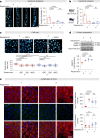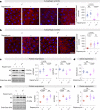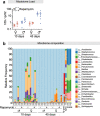Sexual identity of enterocytes regulates autophagy to determine intestinal health, lifespan and responses to rapamycin
- PMID: 37118538
- PMCID: PMC10154239
- DOI: 10.1038/s43587-022-00308-7
Sexual identity of enterocytes regulates autophagy to determine intestinal health, lifespan and responses to rapamycin
Abstract
Pharmacological attenuation of mTOR presents a promising route for delay of age-related disease. Here we show that treatment of Drosophila with the mTOR inhibitor rapamycin extends lifespan in females, but not in males. Female-specific, age-related gut pathology is markedly slowed by rapamycin treatment, mediated by increased autophagy. Treatment increases enterocyte autophagy in females, via the H3/H4 histone-Bchs axis, whereas males show high basal levels of enterocyte autophagy that are not increased by rapamycin feeding. Enterocyte sexual identity, determined by transformerFemale expression, dictates sexually dimorphic cell size, H3/H4-Bchs expression, basal rates of autophagy, fecundity, intestinal homeostasis and lifespan extension in response to rapamycin. Dimorphism in autophagy is conserved in mice, where intestine, brown adipose tissue and muscle exhibit sex differences in autophagy and response to rapamycin. This study highlights tissue sex as a determining factor in the regulation of metabolic processes by mTOR and the efficacy of mTOR-targeted, anti-aging drug treatments.
© 2022. The Author(s).
Conflict of interest statement
The authors declare no competing interests.
Figures

















Similar articles
-
A TORC1-histone axis regulates chromatin organisation and non-canonical induction of autophagy to ameliorate ageing.Elife. 2021 May 14;10:e62233. doi: 10.7554/eLife.62233. Elife. 2021. PMID: 33988501 Free PMC article.
-
Chronic mTOR inhibition in mice with rapamycin alters T, B, myeloid, and innate lymphoid cells and gut flora and prolongs life of immune-deficient mice.Aging Cell. 2015 Dec;14(6):945-56. doi: 10.1111/acel.12380. Epub 2015 Aug 28. Aging Cell. 2015. PMID: 26315673 Free PMC article.
-
Rapamycin-mediated lifespan increase in mice is dose and sex dependent and metabolically distinct from dietary restriction.Aging Cell. 2014 Jun;13(3):468-77. doi: 10.1111/acel.12194. Epub 2014 Feb 9. Aging Cell. 2014. PMID: 24341993 Free PMC article.
-
The Target of Rapamycin Signalling Pathway in Ageing and Lifespan Regulation.Genes (Basel). 2020 Sep 3;11(9):1043. doi: 10.3390/genes11091043. Genes (Basel). 2020. PMID: 32899412 Free PMC article. Review.
-
Autophagy and cardiovascular aging: lesson learned from rapamycin.Cell Cycle. 2012 Jun 1;11(11):2092-9. doi: 10.4161/cc.20317. Epub 2012 Jun 1. Cell Cycle. 2012. PMID: 22580468 Free PMC article. Review.
Cited by
-
Trends in intestinal aging: From underlying mechanisms to therapeutic strategies.Acta Pharm Sin B. 2025 Jul;15(7):3372-3403. doi: 10.1016/j.apsb.2025.05.011. Epub 2025 May 22. Acta Pharm Sin B. 2025. PMID: 40698139 Free PMC article. Review.
-
Inhibition of S6K lowers age-related inflammation and increases lifespan through the endolysosomal system.Nat Aging. 2024 Apr;4(4):491-509. doi: 10.1038/s43587-024-00578-3. Epub 2024 Feb 27. Nat Aging. 2024. PMID: 38413780 Free PMC article.
-
Cell-Type-Specific Autophagy in Human Leukocytes.FASEB J. 2025 Jun 30;39(12):e70708. doi: 10.1096/fj.202402377R. FASEB J. 2025. PMID: 40503584 Free PMC article.
-
Sex as a biological variable in ageing: insights and perspectives on the molecular and cellular hallmarks.Open Biol. 2024 Oct;14(10):240177. doi: 10.1098/rsob.240177. Epub 2024 Oct 30. Open Biol. 2024. PMID: 39471841 Free PMC article. Review.
-
Sex, tissue, and mitochondrial interactions modify the transcriptional response to rapamycin in Drosophila.BMC Genomics. 2024 Aug 7;25(1):766. doi: 10.1186/s12864-024-10647-x. BMC Genomics. 2024. PMID: 39107687 Free PMC article.
References
Publication types
MeSH terms
Substances
Grants and funding
LinkOut - more resources
Full Text Sources
Molecular Biology Databases
Miscellaneous

